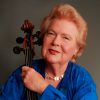
“Which Hand Do You Hear?”
Bonnie Hampton
When Paul Katz invited me to participate in the “CelloBello” Blog, I was intrigued and immediately saw his idea of a free exchange of cellists sharing their experiences, exploring ideas together and just being in contact as a larger community. As cellists,we have a rich heritage and spirit and we certainly love that instrument a great deal. Otherwise, why would we carry it all over the world!
There is so much to explore, but one thing which I find an endless investigation is the whole use of the bow. Of course, all the issues of the left hand are immediate. We play the notes. Expressively, our uses of vibratos are part of our individual “voice,” but while one might call the work of the left hand, our craft, how we develop and use our bow arms has such an effect on how we express ourselves as musicians. From our very beginnings, how we hold the bow, how we develop tone qualities, how we learn bow speeds and different arm and finger weights. While we have become more global and one doesn’t quite as clearly define the different “schools” of bow holds, Franco/Belgium, German, Russian and in this country a mixture everywhere, one does hear some of the characteristics in the playing of the differing bow uses.
Recently, I logged on to YouTube and looked and listened to about 20 cellists to notice the different holds and uses. While there are of course physical differences, there are basic principles which one sees in the finest cellists. There is the balance and freedom and a open flow of energy through the body. So that is a given, and then comes all the wonderful individual playing.
About now, anyone who has read this far is saying, what is she going on about, that is all obvious. Well, when we are playing Bach, for instance, where is our attention? Yes, we are trying to play the notes clearly and with good intonation and articulation, and of course, we have worked out our bowings, but how often are we really thinking and hearing the music through our bows while we are playing? We are just too busy taking care of the left hand.
In all kinds of situations, when we are working to get more clarity with a passage we work with the left hand, but often it is the bow use which makes the difference. In virtuoso passages it is often the bow contact which can liberate the left hand to have more flexibility and facility.
One hears the difference in the German hold, with its broader sweep to the Franco/Belgium with its use of more finger contact and articulation. Then there is the whole question of the kind of sound one is searching for. But all these are questions for another discussion. These are issues which interest me a great deal, but I do not see them discussed that often. We often get used to playing from habits without necessarily questioning or examining whether we are finding the means for our own individual expression and communication.
Subjects: Artistic Vision
Tags: Bonnie, cello, cellobello, character, clarity, communication, Coordination, discussion, Experience, exploration, expression, Hampton, hands, improvement, individual voice, individuality, Listening, music, musicianship, passion, personality, possibilities, searching, Sound, Teaching, vibrato, virtuosity
